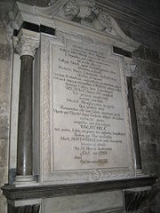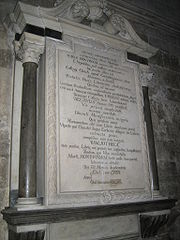
Lincoln Cathedral Library
Encyclopedia
The Lincoln Cathedral Library is a library of Lincoln Cathedral
, Lincolnshire
, England.
As well as a reference collection of c.10,000 items, there are 260 mediæval manuscripts, including works of theology, canon law, devotional books, music and literature, and the following:
The devotional books include an illuminated book of hours
which is small enough to fit into a pocket.
Mediæval manuscripts are among the books on display during the annual exhibition in the Mediæval Library, which runs from spring to autumn.
By 1422 a new, chained library had been built over the east walk of the Cloister, adjoining the Chapter House. Three of the mediæval reading desks and one bench survive in the Mediæval Library, which was built to accommodate around a hundred manuscripts.
 Michael Honywood was made Dean
Michael Honywood was made Dean
of Lincoln at the Restoration of the Monarchy
in 1660, with the huge task of repairing the fabric of the cathedral, ravaged by the Parliamentarian soldiers during the Civil War. General repairs took him until 1674, when he was finally able to begin his cherished project of providing a new library building with £780 of his own money on the site of the ruined north cloister.
Honywood commissioned the design from Sir Christopher Wren, who also supervised throughout, as is indicated by a page which survives in the Cathedral collections, setting out the prices for painting and gilding, and written and signed by Wren. The external Tuscan Doric
colonnade
of the exterior is serenely classical yet the inside is full of Baroque features: advancing and receding planes and cornice, which all give interest to a long, narrow room; and the trompe l'oeil
marbling. Through removal of the added paint layers some of the original marbling has been revealed, where it has not been revealed (due to expense and conservation concerns) a reproduction marbling has been painted over all of the layers.
The terms laid out in the contracts for the building specified that the building should be completed in two years.
He bequeathed his 5,000 books (including one of only 250 manuscript versions of Chaucer's Canterbury Tales) to the Dean and Chapter - these are still in the building built for them, one of only 2 surviving Wren libraries.
Lincoln Cathedral
Lincoln Cathedral is a historic Anglican cathedral in Lincoln in England and seat of the Bishop of Lincoln in the Church of England. It was reputedly the tallest building in the world for 249 years . The central spire collapsed in 1549 and was not rebuilt...
, Lincolnshire
Lincolnshire
Lincolnshire is a county in the east of England. It borders Norfolk to the south east, Cambridgeshire to the south, Rutland to the south west, Leicestershire and Nottinghamshire to the west, South Yorkshire to the north west, and the East Riding of Yorkshire to the north. It also borders...
, England.
Collections
Lincoln cathedral library is perhaps the finest rare book library in the East Midlands and among the top five cathedral library collections in England. In addition there is a modern reference library which is open to the public. The Cathedral employs a full-time librarian (and an assistant) to manage the collection: the current librarian is Dr Nicholas Bennetthttp://www.lincolncathedral.com/xhtml/default.asp?UserLinkID=58870.As well as a reference collection of c.10,000 items, there are 260 mediæval manuscripts, including works of theology, canon law, devotional books, music and literature, and the following:
- Text of the Venerable Bede
- Lincoln’s Chapter Bible - commissioned for the new cathedral by Nicholas, Archdeacon of Huntingdon in the late 11th century
- The fifteenth-century "Thornton Romances" found in the Lincoln Thornton ManuscriptLincoln Thornton ManuscriptThe Lincoln Thornton Manuscript is a medieval manuscript compiled and copied by the fifteenth-century English scribe and landowner Robert Thornton. The manuscript is notable for containing single versions of important poems such as the Alliterative Morte Arthure and Sir Perceval of Galles, and...
- includes the earliest written account of the death of King Arthur, and was a source for the poet Thomas MaloryThomas MalorySir Thomas Malory was an English writer, the author or compiler of Le Morte d'Arthur. The antiquary John Leland as well as John Bale believed him to be Welsh, but most modern scholars, beginning with G. L...
's Morte d'Arthur.
The devotional books include an illuminated book of hours
Book of Hours
The book of hours was a devotional book popular in the later Middle Ages. It is the most common type of surviving medieval illuminated manuscript. Like every manuscript, each manuscript book of hours is unique in one way or another, but most contain a similar collection of texts, prayers and...
which is small enough to fit into a pocket.
Mediæval manuscripts are among the books on display during the annual exhibition in the Mediæval Library, which runs from spring to autumn.
Pre civil war
In the mediæval era the manuscripts were kept in a chest or cupboard, and scholars came from great distances to consult them.By 1422 a new, chained library had been built over the east walk of the Cloister, adjoining the Chapter House. Three of the mediæval reading desks and one bench survive in the Mediæval Library, which was built to accommodate around a hundred manuscripts.
Wren Library

Dean (religion)
A dean, in a church context, is a cleric holding certain positions of authority within a religious hierarchy. The title is used mainly in the Anglican Communion and the Roman Catholic Church.-Anglican Communion:...
of Lincoln at the Restoration of the Monarchy
English Restoration
The Restoration of the English monarchy began in 1660 when the English, Scottish and Irish monarchies were all restored under Charles II after the Interregnum that followed the Wars of the Three Kingdoms...
in 1660, with the huge task of repairing the fabric of the cathedral, ravaged by the Parliamentarian soldiers during the Civil War. General repairs took him until 1674, when he was finally able to begin his cherished project of providing a new library building with £780 of his own money on the site of the ruined north cloister.
Honywood commissioned the design from Sir Christopher Wren, who also supervised throughout, as is indicated by a page which survives in the Cathedral collections, setting out the prices for painting and gilding, and written and signed by Wren. The external Tuscan Doric
Tuscan order
Among canon of classical orders of classical architecture, the Tuscan order's place is due to the influence of the Italian Sebastiano Serlio, who meticulously described the five orders including a "Tuscan order", "the solidest and least ornate", in his fourth book of Regole generalii di...
colonnade
Colonnade
In classical architecture, a colonnade denotes a long sequence of columns joined by their entablature, often free-standing, or part of a building....
of the exterior is serenely classical yet the inside is full of Baroque features: advancing and receding planes and cornice, which all give interest to a long, narrow room; and the trompe l'oeil
Trompe l'oeil
Trompe-l'œil, which can also be spelled without the hyphen in English as trompe l'oeil, is an art technique involving extremely realistic imagery in order to create the optical illusion that the depicted objects appear in three dimensions.-History in painting:Although the phrase has its origin in...
marbling. Through removal of the added paint layers some of the original marbling has been revealed, where it has not been revealed (due to expense and conservation concerns) a reproduction marbling has been painted over all of the layers.
The terms laid out in the contracts for the building specified that the building should be completed in two years.
He bequeathed his 5,000 books (including one of only 250 manuscript versions of Chaucer's Canterbury Tales) to the Dean and Chapter - these are still in the building built for them, one of only 2 surviving Wren libraries.

